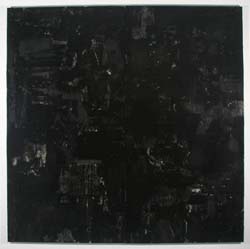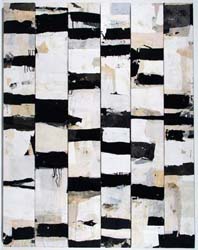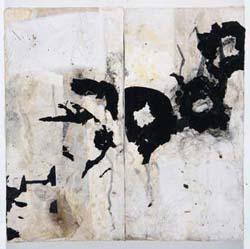
|
||
|
Portland art blog + news + exhibition reviews + galleries + contemporary northwest art
|
||
Nerve Block Jerry Iverson strips painting raw in the "Nerve Block" series at Pulliam Deffenbaugh. By reducing his palette to only pure white and pure black, Iverson's compositions have a graphic shock quality which he plays against the traditional vocabulary of abstract painting: form, balance, compositional harmony. Iverson's work is like watching a master fencer working with a cattle prod instead of a foil. It seems uncertain whether the elegance of his movements will be readable within the unrelenting, graphic organization of his compositions.

In an all black painting entitled Where We Go, Iverson treads the water of minimalism. One gets the uneasy feeling that Frank Stella is looking over your shoulder, sipping a cup of coffee. The painting seems heavy, full of a gravitas similar to minimalism's assertion of the unavoidable truth of materiality. But the gravitas in Iverson's work is not an assertion of the materiality of the paint itself, it is soulful, full of motion, expressive. 
Iverson searches for something spiritual and elemental. Just as Barnett Newman explored ideas of heroic individualism using a single compositional idea "the zip", Iverson explores experience and memory using his single compositional idea: "the nerve block." The arrangement of the nerve blocks into patterns seems an elemental process, a record of encoding experience. Remove the complexity of details from experience and only patterns are left. Many of Iverson's paintings have an all too coincidental similarity with genetic testing patterns. 
In Iverson's work, the binary palette serves the same expressive function that it does in Chinese brush painting: it removes every consideration but the motion of the brush, reducing painting to an essential responsive act reflecting the spirit of the actor. Nerve Block • New Works • Jerry Iverson • Nov 1 - 26 Pulliam Deffenbaugh Gallery • 929 NW Flanders St • Portland, OR • 503•228•6665 Posted by Isaac Peterson on November 08, 2005 at 8:15 | Comments (0) Comments Post a comment Thanks for signing in, . Now you can comment. (sign out)
(If you haven't left a comment here before, you may need to be approved by
the site owner before your comment will appear. Until then, it won't appear
on the entry. Thanks for waiting.)
|
| s p o n s o r s |
 |
 |
 |
 |
 |
 |
 |
 |
 |
 |
 |
 |
 |
 |

|
Site Design: Jennifer Armbrust | • | Site Development: Philippe Blanc & Katherine Bovee | |

